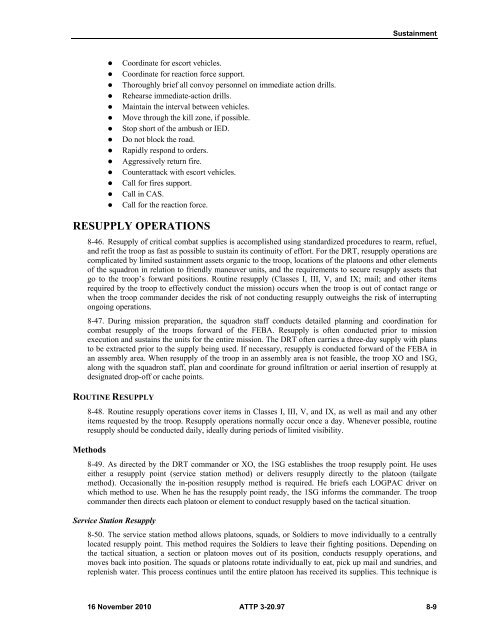Dismounted Reconnaissance Troop - Army Electronic Publications ...
Dismounted Reconnaissance Troop - Army Electronic Publications ...
Dismounted Reconnaissance Troop - Army Electronic Publications ...
Create successful ePaper yourself
Turn your PDF publications into a flip-book with our unique Google optimized e-Paper software.
Coordinate for escort vehicles.<br />
Coordinate for reaction force support.<br />
Thoroughly brief all convoy personnel on immediate action drills.<br />
Rehearse immediate-action drills.<br />
Maintain the interval between vehicles.<br />
Move through the kill zone, if possible.<br />
Stop short of the ambush or IED.<br />
Do not block the road.<br />
Rapidly respond to orders.<br />
Aggressively return fire.<br />
Counterattack with escort vehicles.<br />
Call for fires support.<br />
Call in CAS.<br />
Call for the reaction force.<br />
RESUPPLY OPERATIONS<br />
Sustainment<br />
8-46. Resupply of critical combat supplies is accomplished using standardized procedures to rearm, refuel,<br />
and refit the troop as fast as possible to sustain its continuity of effort. For the DRT, resupply operations are<br />
complicated by limited sustainment assets organic to the troop, locations of the platoons and other elements<br />
of the squadron in relation to friendly maneuver units, and the requirements to secure resupply assets that<br />
go to the troop’s forward positions. Routine resupply (Classes I, III, V, and IX; mail; and other items<br />
required by the troop to effectively conduct the mission) occurs when the troop is out of contact range or<br />
when the troop commander decides the risk of not conducting resupply outweighs the risk of interrupting<br />
ongoing operations.<br />
8-47. During mission preparation, the squadron staff conducts detailed planning and coordination for<br />
combat resupply of the troops forward of the FEBA. Resupply is often conducted prior to mission<br />
execution and sustains the units for the entire mission. The DRT often carries a three-day supply with plans<br />
to be extracted prior to the supply being used. If necessary, resupply is conducted forward of the FEBA in<br />
an assembly area. When resupply of the troop in an assembly area is not feasible, the troop XO and 1SG,<br />
along with the squadron staff, plan and coordinate for ground infiltration or aerial insertion of resupply at<br />
designated drop-off or cache points.<br />
ROUTINE RESUPPLY<br />
8-48. Routine resupply operations cover items in Classes I, III, V, and IX, as well as mail and any other<br />
items requested by the troop. Resupply operations normally occur once a day. Whenever possible, routine<br />
resupply should be conducted daily, ideally during periods of limited visibility.<br />
Methods<br />
8-49. As directed by the DRT commander or XO, the 1SG establishes the troop resupply point. He uses<br />
either a resupply point (service station method) or delivers resupply directly to the platoon (tailgate<br />
method). Occasionally the in-position resupply method is required. He briefs each LOGPAC driver on<br />
which method to use. When he has the resupply point ready, the 1SG informs the commander. The troop<br />
commander then directs each platoon or element to conduct resupply based on the tactical situation.<br />
Service Station Resupply<br />
8-50. The service station method allows platoons, squads, or Soldiers to move individually to a centrally<br />
located resupply point. This method requires the Soldiers to leave their fighting positions. Depending on<br />
the tactical situation, a section or platoon moves out of its position, conducts resupply operations, and<br />
moves back into position. The squads or platoons rotate individually to eat, pick up mail and sundries, and<br />
replenish water. This process continues until the entire platoon has received its supplies. This technique is<br />
16 November 2010 ATTP 3-20.97 8-9

















